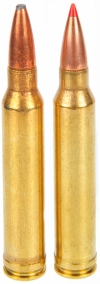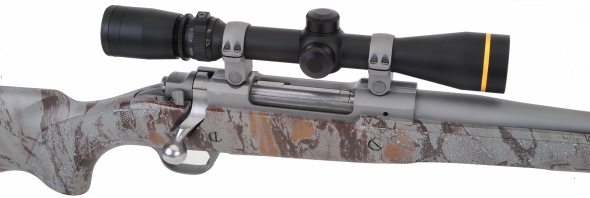
I like to hunt, but when you live in the woods and see the same animals all of the time, you tend not to want to shoot them. They just don’t look as good on the dinner table. So we tolerate one another and they are gracious enough to yield territory on a range day. A quick project wrap up…
 A Leupold scope was installed and some baseline data was collected with factory ammunition.
A Leupold scope was installed and some baseline data was collected with factory ammunition.
| Ammo | Bullet Grains |
Rated FPS |
Actual FPS |
| Remington Core-Lokt | 150 | 3290 | 3286 |
| Hornady Superformance | 180 | 3130 | 3156 |
Three shot groups for the Remington were a solid and consistent 0.8″ to 0.9″, Hornady shot between 0.9″ and 1.1″ @ 100 yards. Groups were shot with and without the brake installed, delivering similar size groups. A barely measureable point of impact shift was observed using the substitute weight and about a half inch shift with neither brake or weight in place.
In an Internet world where every shooter can manage quarter MOA groups at five hundred yards the Ruger’s accuracy might be viewed as moderate. However, in a real world where rifles are shot without the aid of a game controller, accuracy is excellent; two random types of inexpensive ammo. A little juggling of factory types to optimize, or even a little handloading and a group size reduction by a third should easily be attainable.
The Ruger Hawkeye FTW Hunter Rifle is not a lightweight at 8.2 Lbs… about 9 Lbs with the scope installed. Something most would find a good quality in a 300 Winchester Magnum and a factor that makes the Hawkeye FTW very manageable even without the brake installed.

Shooting from a bench with frequency, the brake really took the smack out of the recoil, making it feel like a 308 Win sporter. The noise level is higher with the brake in place, but wearing ear plugs under earmuffs seems to be a satisfactory solution for extended range work. I personally do not think I would hunt with the brake in place, just the offsetting weight.

I juggled half inch recoil pad spacers and tried different pull lengths. Twelve and three-quarter inches was too short, placing my cheek bone at an uncomfortable position on the stock’s comb. Fourteen and one quarter inches stretched out my rotator cuff and left me with a slight bruise. Thirteen and one quarter inches was comfortable in all shooting positions. Trying to stand from a sitting position while holding a rifle caused me to roll over. A need for gym time… and balance.
Conclusion
There is not much I can add that was not covered in Part 1 or earlier here in Part 2. The Ruger Hawkeye FTW Hunter Rifle is a purpose built firearm and that purpose is all weather hunting. The barrel length is optimal for the cartridge, the heft suits the combination and the stock and hardware are robust. I suspect the combination would deliver many years of excellent service

Ruger’s Hawkeye FTW Hunter Rifle Part 1
Ruger’s Hawkeye FTW Hunter Rifle Part 2

Email Notification